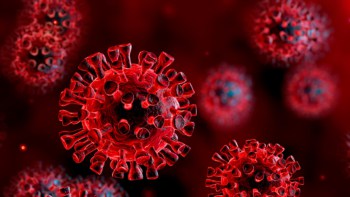
The ingenious way that mushrooms and certain other fungi fire spores into the atmosphere in order to reproduce has been mimicked by a team of engineers and fungal biologists. These organisms disperse billions or even trillions of spores so that enough land in a suitable environment for them to reproduce. However, the phylum Basidiomycota – which includes all mushrooms and numerous other fungi – has evolved an ingenious dispersal method that uses the energy released by coalescing water droplets to boost the chances of reproduction. By mimicking this “surface-tension catapult” in the lab, the researchers’ work could inspire new approaches to dealing with destructive fungi or lead to artificial methods for dispersing tiny particles.
The basic details of how Basidiomycota launch spores were first worked out in the early 20th century, by the British–Canadian mycologist (fungal biologist) Arthur Henry Reginald Buller. He discovered that in the seconds before launch, the spore secretes chemicals that attract water so that two separate droplets grow on one side of the spore – a spherical “Buller’s droplet” on a small projection at the base, and a larger, flatter “adaxial droplet” higher up.
When the droplets make contact, they coalesce, with the resulting decrease in surface energy propelling the spore away from the gill at around 1 m/s. The spore is decelerated by viscous drag from the atmosphere, and falls vertically down until it is carried away by air currents. It is important that the sticky spore be launched directly away from the surface because, if it did not get well away, it might re-attach and fail to disperse.
Missing puzzle piece
The energetics of this process were clear, says engineer Chuan-Hua Chen of Duke University in the US. However, he says, it occurs fast – even though Nicholas Money of Miami University and colleagues in 2005 filmed the process at 100,000 frames per second, the dynamics could not be captured, and the process of how the fungus achieves dispersion was unclear.
“There was a big piece of the puzzle missing,” says Chen. “It was like you were building a cannon, and knowing that you could use gunpowder to fire stuff – but you didn’t know where the ball was, so you didn’t know how it was directed.”
Together with two authors of the 2005 paper, his group explored “several different conceptual models over a number of years”, before arriving at one that could explain the phenomenon. Researchers know that, in the seconds before the spore is launched, the structure holding it partially breaks down until it can resist compression but not tension.
Chen and colleagues worked out that the pressure is higher inside Buller’s drop than inside the upper, adaxial drop. So when the two droplets coalesce, the net fluid flow must be upwards. By Newton’s third law, the upward acceleration of the fluid then pushes down on the spore, exerting a compressive force that the structure withstands. However, when the fluid reaches the upper edge of the spore, it needs to be pulled back, which requires a downward force on the fluid, pulling up on the spore and exerting a tensile force the structure could not withstand. The spore would then be pulled directly off the structure.
Model launch
To test this hypothesis, the researchers built a model droplet-launching process, using a polystyrene “spore” hundreds of times larger than a real spore and depositing droplets on one surface with an inkjet printer. The distances and fluid quantities involved were much larger, so the launch process unfolded much more slowly: “We can see the coalescence-induced launching process in fine detail and therefore determine the mechanism by which the spore determines its launching direction,” Chen explains.
Many Basidiomycota fungi are vicious pathogens. “Understanding the details of the launch mechanism may help us either to enhance, or more likely to inhibit, the spore launching mechanism, and therefore to stop the spread of certain pathogens,” says Chen.
Money, who was not involved in the current research, suspects that few researchers will be surprised by the model. “Given the geometry of this situation, if you jump from a pillar, you’re almost bound to go upwards,” he says. Nevertheless, Money sees significant value in the way the model “makes sense of what we know happens in nature” and suspects there may be biomimetic applications: “Because of the supreme efficiency of this method,” he says, “there must be some applications in engineering that can make use of the coalescence of water droplets to move things around.”
The research is published in The Journal of the Royal Society Interface.



